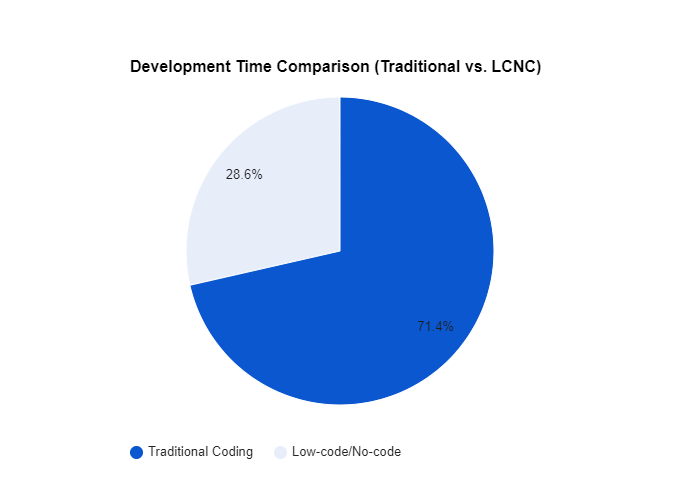The software development landscape is undergoing a significant shift with the rise of low-code/no-code development platforms. These platforms enable users with minimal coding experience to build applications visually using drag-and-drop interfaces and pre-built components. While traditional coding still holds its place in complex, custom-built software, low-code/no-code (LCNC) is making waves by democratizing app creation, allowing businesses and individuals to build solutions without solely relying on professional developers. Also, build apps faster with reduced costs.
Low-Code/No-Code Development Landscape
Low-code and no-code platforms differ slightly in their approaches.
Low-code platforms
It requires some basic coding knowledge or scripting skills to customize pre-built functionalities. They offer more flexibility and control compared to no-code platforms but still maintain a user-friendly interface.
No-code platforms
Eliminate the need for coding. They rely on drag-and-drop functionality, pre-built templates, and visual editors to enable users to build applications without writing any code.
Benefits of Low-Code/No-Code Development

Faster Development
LCNC platforms significantly accelerate the development process compared to traditional coding. Pre-built components and visual interfaces streamline development, allowing users to build applications in a fraction of the time. According to Kissflow, low-code solutions can reduce enterprise application development time by up to 60% compared to traditional methods.
Reduced costs
By eliminating the need for extensive coding resources and potentially hiring additional developers, LCNC platforms can significantly reduce development costs. ColorWhistle states that compared to conventional development platforms, no-code solutions consume 70% fewer resources, translating to cost savings for businesses.
Democratization of development
LCNC empowers non-technical users like business analysts, marketing professionals, and citizen developers to build basic applications that meet their specific needs. A 2021 study by Forrester found that 41% of organizations have active citizen development initiatives, and 20% of those who don’t are either evaluating or planning to start such initiatives. LCNC bridges the gap between business requirements and technical implementation, fostering greater collaboration and agility.
Improved user experience
Many LCNC platforms offer intuitive interfaces and pre-built user interfaces (UIs) that ensure consistency and user-friendliness. This allows users to focus on the functionality of the application without getting bogged down in the intricacies of UI design. A report by Mendix revealed that 70% of business decision-makers believe low-code development improves the user experience of applications.
Increased efficiency
LCNC platforms streamline workflows by automating repetitive tasks and integrating them with existing systems. This allows users to focus on more strategic initiatives and improve overall operational efficiency. Kissflow also states that companies that use low-code platforms to build customer-facing apps increase revenue by 58% on average, likely due to faster development cycles and improved user experiences.
Examples of Low-Code No-Code in Action
- Citizen Development: A marketing team at a retail company uses a low-code platform to develop a mobile app for loyalty program management. The app allows customers to track their points, redeem rewards, and receive personalized offers without requiring extensive coding expertise from the marketing team.
- Rapid Prototyping: A product development team uses a no-code platform to quickly prototype a new feature for their software product. The prototype allows them to gather user feedback and iterate on the design before investing significant resources in full-fledged development.
- Internal Workflow Automation: An HR department implements a low-code platform to automate the onboarding process for new hires. The platform streamlines the collection of information, document management, and task approvals, resulting in a faster and more efficient onboarding experience.
Challenges and Considerations:
While LCNC offers significant benefits, it’s important to consider these challenges:
- Limited customization: LCNC platforms typically offer pre-built functionalities and templates, which may limit the ability to customize applications for highly specific needs.
- Vendor lock-in: Switching platforms can be difficult due to the proprietary nature of some LCNC platforms. This can lead to vendor lock-in, where businesses become reliant on a specific vendor for future development.
- Security concerns: Security is a crucial aspect of any application. It’s essential to evaluate the security features and practices of LCNC platforms before deploying them for building sensitive applications.
- Integration complexity: Integrating LCNC applications with existing systems may require additional development efforts, especially if the existing systems are not well-integrated or use outdated technologies.
Popular Low-Code/No-Code Development tools and platforms
Here are some popular low-code/no-code development tools and platforms:
1. Bubble
- Category: Low-code
- Strengths: Powerful visual development environment; extensive plugin marketplace, good for building complex web applications.
- Weaknesses: Can be expensive for larger teams, and requires some learning curve.
2. Webflow
- Category: Low-code
- Strengths: Excellent for building responsive websites and web applications, user-friendly interface, built-in CMS.
- Weaknesses: Limited functionality for complex business logic, not ideal for native mobile apps.
3. Mendix
- Category: Low-code
- Strengths: Enterprise-grade platform with robust security features, good for building large-scale applications, good integration capabilities.
- Weaknesses: Steeper learning curve, can be expensive for large teams.
4. Glide
- Category: No-code
- Strengths: Easy to use, ideal for building simple mobile apps from spreadsheets or Google Sheets, affordable.
- Weaknesses: Limited customization options, not suitable for complex applications.
5. Adalo
- Category: Low-code
- Strengths: User-friendly interface, good for building native mobile apps and web apps, offline functionality.
- Weaknesses: Limited data storage, can be expensive for larger teams.
6. Zoho Creator
- Category: Low-code
- Strengths: Affordable, good for building internal business applications, integrates with other Zoho products.
- Weaknesses: Limited design flexibility, not ideal for building complex user interfaces.
7. Microsoft Power Apps
- Category: Low-code
- Strengths: Integrates seamlessly with other Microsoft products, good for building business process automation applications, extensive documentation and support.
- Weaknesses: Can be expensive for large teams, requires some familiarity with Microsoft products.
8. Appian
- Category: Low-code
- Strengths: Powerful platform for building complex workflow applications, good for large enterprises, robust security features.
- Weaknesses: Steeper learning curve, expensive.
9. Caspio
- Category: Low-code
- Strengths: User-friendly interface, good for building database-driven applications, affordable.
- Weaknesses: Limited design flexibility, not ideal for building complex user interfaces.
10. Outsystems
- Category: Low-code
- Strengths: Powerful platform for building enterprise-grade applications, good for large teams, scalable.
- Weaknesses: Steeper learning curve, expensive.
The Future of Low-code/No-code Development
The LCNC market is projected to experience significant growth in the coming years, with Gartner predicting that 70% of new applications will be developed using low-code or no-code.







